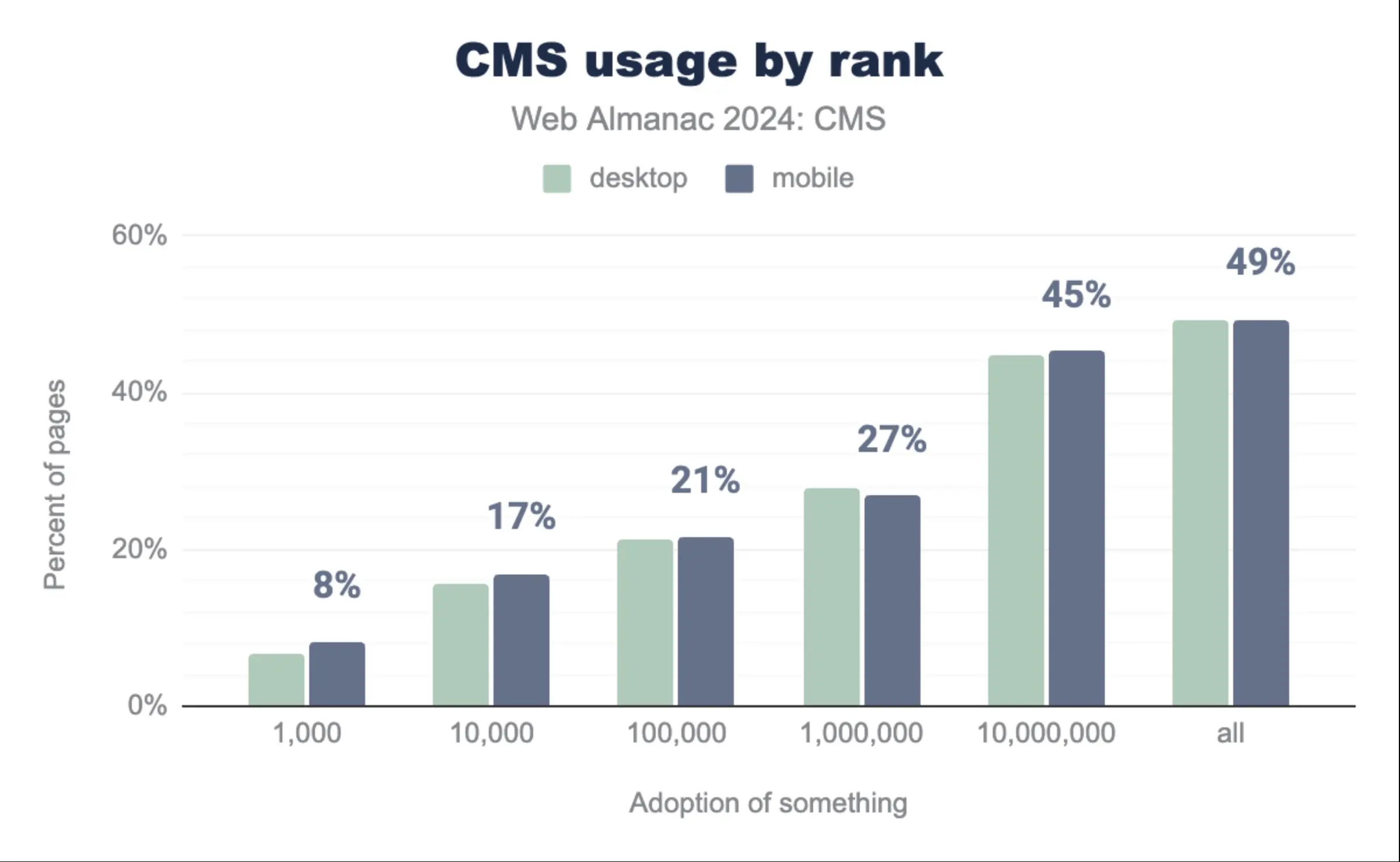The Web Almanac 2024, a detailed and data-driven report on the state of the web, has been published. This latest edition gathers metadata from approximately 17 million websites, offering fascinating insights into various aspects of the web. Personally, I found the CMS Sections to be the most intriguing. It includes some surprises, even as the data continues trends from past years. This detailed overview provides web engineers with crucial insights into what’s thriving on the web.
Key Trends in Content Management Systems (CMS)
The adoption of CMS platforms continues to grow year-over-year on both desktop and mobile websites. Despite the fact there is ton of new tools on the market and the effort required to build and deploy simple pages with tools like Gatsby, Astro, or Hugo has significantly decreased over the past few years. Let’s be honest, though—95% of pages built with CMS platforms don’t truly need them. Most are simple sites with around 10 subpages that could easily be converted to static HTML and hosted on GitHub Pages with minimal effort.
WordPress Dominates the CMS Market
With over 35% mobile adoption in 2024, WordPress remains the undisputed leader in the CMS market. It’s followed by Wix (2.8%), Joomla (1.5%), Squarespace (1.5%), and Drupal (1.2%). Not even the latest controversies surrounding Automattic seem to have affected its dominance.
WordPress powers 5.7 million websites. By comparison, Wix, its closest competitor, powers just 456,253 sites. While Joomla and Drupal continue to lose market share, Wix and Squarespace are growing steadily, now accounting for a combined 1.3% of analyzed websites. Adoption of WordPress competitors seems to be extremaly small and basically it means switch to any platform is jumping into absolute niche.
CMS Adoption Among Large Businesses
According to the report, CMS platforms are used by only 8% of the top 1,000 websites, despite being used by 49% of mobile sites overall.
 source: https://almanac.httparchive.org/en/2024/cms
source: https://almanac.httparchive.org/en/2024/cms
This discrepancy suggests that CMS adoption correlates with website ranking. Among the top-ranked pages, only 8% use CMS platforms. In contrast, lower-ranked pages (10,000,000+ rank) show 45% CMS adoption.
How can this be?
It aligns with the idea that many older blogs and websites—built with CMS platforms during the blogging boom—remain online but outdated, languishing at the tail end of page rank data.
For top-ranked pages, particularly those of large businesses, the story is different. Many rely on custom-built CMS solutions or headless architectures that are harder to identify in datasets. As the authors of the report note, it’s likely these solutions are simply not captured in the data.
The Impact of CMS on Web Performance
The Interaction to Next Paint (INP) metric replaced First Input Delay (FID) as the primary interactivity Core Web Vitals metric on March 12, 2024. Since then, web engineers have focused on achieving INP scores below 200ms to maintain “green” performance ratings in Google Search Console.
Given that CMS platforms power 49% of the web, even small improvements to Core Web Vitals can have a significant impact. WordPress developers, in particular, have made notable contributions:
- Median Lighthouse mobile performance improved from 33 to 38 points.
- Mobile INP pass rate increased from 69% to 82% 🔥
Conclusion: WordPress Powers the Web (and PHP Too)
Like it or not, WordPress still powers a large portion of the web. And by extension, so does PHP.
PHP is used by 75.4% of all websites where the technology is identified, according to the W3Tech report.
In 2024, WordPress remains the king of CMS platforms, and its ecosystem continues to shape the future of web performance and accessibility.